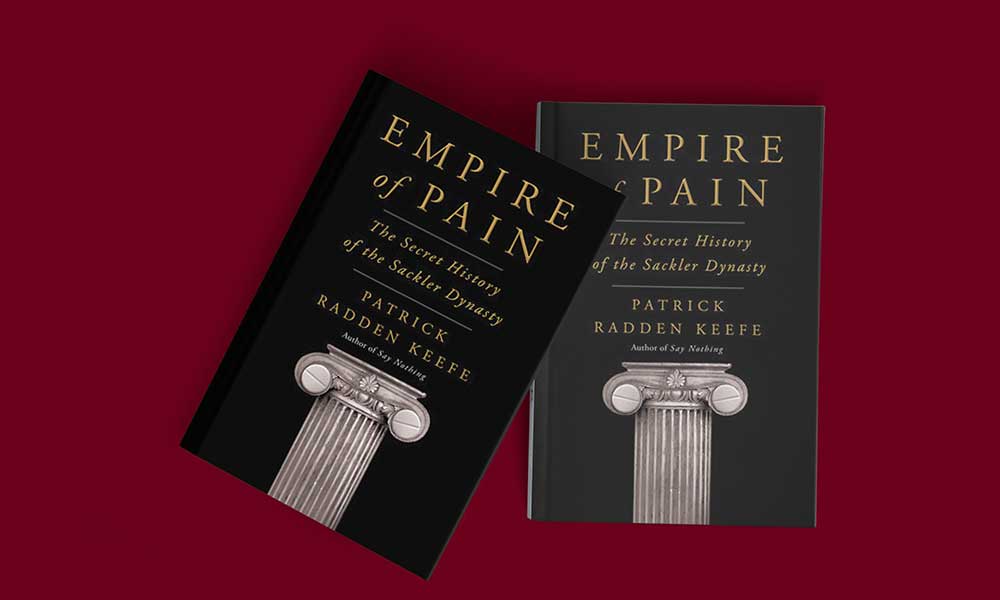Book Review | Greed, Drugs and Philanthropy

Empire of Pain: The Secret History of the Sackler Dynasty
By Patrick Radden Keefe
Doubleday; 560 pp. ; $32.50
In this time of corrective unnamings—to remove traces of admiration or gratitude for the morally reevaluated—the names of unrepentant slaveholders, Confederate generals, contemporary sexual predators and other assorted wrongdoers have been erased or proposed for erasure from college dorms, military bases, city streets and more.
In that effort, the Sackler family presents unusual complications. First, they are not a single wrongdoer but a clan: three psychiatrist brothers born to a Jewish immigrant family of modest means, their multiple wives, ex-wives, children and at least one grandchild. Second, their wrongdoing involved so many accomplices as to deplete the national eraser supply. Third, the name Sackler became widely known not when they made their money but when they gave a good deal of it away to philanthropy. It is as though people knew of only the Ford Foundation and Rockefeller University, not Henry Ford or John D. Rockefeller. The Sacklers’ philanthropy won them not just names on buildings but honorary academic degrees and even honorary knighthoods.
Two generations of the Sackler family made billions advertising and marketing pharmaceuticals, working the intersection of medicine and commerce. Along the way, they took advantage of physicians who pocketed speaking fees in exchange for vouching for the safety of drugs that were potentially unsafe; federal regulators who coddled them and their enterprises (and in one notable case went on to a lucrative career with them after a discreet interval); and a legal system that, on everything from patents to bankruptcy, tilted every litigious playing field their way. They enjoyed the services of high-priced, well-placed advocates such as the pre-Trumpified Rudolph Giuliani, Washington superlawyer Clark Gifford and litigator and sometime prosecutor Mary Jo White.
The most successful product of their family-controlled firm, Purdue Pharma, was OxyContin, the powerful opioid oxycodone in pill form, coated with a substance that slowed the release of the drug and thus made it, according to the Sacklers and their army of sales reps, non-addictive. A subsequent epidemic of addiction to opioids, including OxyContin, put the lie to that spurious claim. Even so, the Sacklers continued to campaign for the use of powerful painkillers—once reserved for patients in the agonizing death throes of cancer—for people suffering from back pain and broken limbs. By the 1990s, American medicine was swinging away from a decades-long aversion to using addictive drugs like morphine for all but their dying patients to an acknowledgment that pain was being undertreated and ought to be recognized as a vital sign. The Sacklers’ campaigning for OxyContin was a sign of the times.
Secrecy kept their business histories unknown to the public, while the name Sackler became very well known for the family’s extensive philanthropy.
While it was hardly the only opioid unleashed on the market (and on the street), the company’s aggressive marketing of OxyContin and its denial that addiction was linked to the drug’s potency made Purdue Pharma a proud leader in destigmatizing opioids when that leadership was a cause for pride—and a prime culprit when the rising use of prescription drugs as street drugs became undeniable. When OxyContin’s coating was toughened to make the pill harder for addicts to crack and cook, many turned to the next best thing, heroin or fentanyl.
Having kept their business within the family, the Sacklers escaped scrutiny from stockholders and outside directors. Secrecy kept their business histories largely unknown to the public, while the name Sackler became very well known for the family’s extensive philanthropy—hence the present wave of unnamings.
The story of the Sacklers, as Patrick Radden Keefe relates it in his superb book Empire of Pain, is primarily about two men: Arthur Sackler and his nephew Richard Sackler. Arthur, born in 1913, was the eldest of the three brothers. The quintessential first-generation American go-getter, Arthur started selling advertising while still in high school and continued doing so in and after medical school. After turning to psychiatry, he managed two careers, physician and medical adman. At Creedmoor, then a sprawling state psychiatric hospital in Queens, New York, he was repelled by the routine resort to electroconvulsive therapy (aka shock treatment) to control patients. He became convinced that mental illness was caused by brain chemistry and that drugs could achieve better results while inflicting less pain. He conducted research with the organic compound histamine that demonstrated as much and permitted many Creedmoor patients to be deinstitutionalized. Arthur Sackler became not merely a psychiatrist but a renowned researcher, a celebrity scientist.
He was also a collector. He began acquiring expensive Asian art in massive quantities, a collection that he donated to the Smithsonian Institution in the 1980s. Few people, even those on the receiving end of his philanthropy, seemed to understand or care how exactly he had amassed his fortune, which was not from his research but through his work running an advertising agency that specialized in drugs.

Photo credit: Anna Shvets
In the 1960s, one client of that agency, Roche, launched two drugs that each became in turn the most successful prescription drugs on the market, the tranquilizers Librium and Valium. The Roche chemist who invented them received, without complaint, Roche’s standard $1 per patent and, after the drugs’ phenomenal successes had been manifest, two bonuses of $10,000 each. Sackler, in return for advertising the drugs, negotiated a series of sales-based bonuses that amounted to a commission and amassed a fortune. While seldom publicly associated with the drug, he was in fact Arthur Sackler, Valium advertising magnate.
To say he cut corners in business is an understatement. An early ad campaign he ran for one drug displayed the names and addresses of physicians who touted the drug’s use. An enterprising journalist discovered that the doctors were fictitious. Sackler published a newspaper for doctors (for many years without publicly acknowledging his ownership) whose articles promoted the drugs his advertising firm was pushing. He secretly held a stake in his best friend’s ad company, ostensibly his rival. That way, when competing drug companies had competing medicines on the market and the same ad agency could not ethically represent both, Sackler could still profit from both. Worst among his offenses was his persistent denial of claims that Valium was being abused. Drug abuse, according to Sackler, was entirely the fault of the abusers. The drug was innocent. Keefe quotes him as saying that people who encountered problems with the drug “must have mixed it with alcohol or cocaine.” A syndicated ask-the-doctor column in 1957 offered the reassurance that “tranquilizers were not making us a nation of drug addicts.” The source of that judgment was Dr. Mortimer Sackler, Arthur’s brother and business partner.
By the time Arthur Sackler’s nephew Richard had launched OxyContin in 1995 as head of the family-owned drug company Purdue Pharma, Arthur was dead and memorialized by museums and universities at home and abroad. The Sackler name was credited with the New York Metropolitan Museum of Art’s monumental acquisition of the ancient Egyptian Temple of Dendur and the Smithsonian’s creation of its museum of Asian art. Sackler gifts often credited the brothers or other close family members in addition to himself.
In Keefe’s telling, Richard Sackler, born in 1945, championed OxyContin even more recklessly than his uncle had done for Valium. Once again, the abuse of a dangerous drug was dismissed as a moral failing of the abusers, not a risk posed by the drug itself; most addiction was described as merely “pseudo-addiction.” Sales reps were urged to concentrate on doctors and pharmacies that were high-volume customers, counting on the most irresponsible if not criminal figures in their professions to pump more and more OxyContin into the market through dubious prescriptions.
When lawsuits were brought by the families of OxyContin addicts who died of overdoses, as well as by state attorneys general, the Sacklers’ lawyers outplayed their critics. In a 2007 federal civil case, the company was fined $600 million for “misdemeanor misbranding.” Keefe quotes Purdue Pharma’s CFO being overheard saying privately: “That’s been in the bank for years. That’s nothing to us.” Three faithful family retainers copped pleas and after serving sentences received millions in payment. No Sackler admitted to any wrongdoing, none served time, and company documents were sealed. Ultimately, in an infuriating coda to the Sackler saga, Keefe reports that the family—as the sole owners of Purdue Pharma—milked the firm of its assets, moved the company headquarters to a friendly jurisdiction, declared bankruptcy there and walked away from a growing wave of contempt for their clan, legally and financially unscathed.
There is a tragic dimension to the Sackler saga. Arthur was a man of immense energy, talent and passion, even if seriously deficient in the scruples department. It is not clear (to me) how exceptional Arthur Sackler’s relentless flackery was in the heyday of Madison Avenue, or, as they say on the website of the Medical Advertising Hall of Fame where he was among the inaugural inductees, Medicine Avenue. That such a pantheon even exists implies a normalization of the trade that he had plied with such great success. Nor is it clear (to me) how so many doctors could prefer the self-righteous and self-serving claims of sales reps to the evidence of opioid abuse crowding their local ERs.
Was Arthur Sackler worthy of the same unnaming as his nephew? The author quotes Dean Harris Berman of Tufts Medical School when his university, pressed by protesters and students, de-Sacklerized in 2019: “Our students find it objectionable to walk into a building that says Sackler on it…” They found the name, said Dr. Berman, “incongruous with the mission of the school…The Sackler name is a problem, whether it’s Arthur Sackler’s or all the Sackler names.”
The elder Sackler’s daughter and his widow (wife number three) argued publicly that the founding Sackler, the researcher, collector and philanthropist, bore no responsibility for the “OxySacklers” who succeeded him and that gifts bearing his name should continue to do so. The Smithsonian, however, made the subtle gesture of implicitly demoting its late patron, “rebranding” the Arthur M. Sackler Gallery and its neighbor the Freer Gallery of Art as the National Museum of Asian Art. (Confession: My own donation to the Freer was to voice that gallery’s tour guide app, “Freer Thinking.”) The Louvre dropped the name of its Sackler Wing, and the Met placed the name of its Sackler Wing (home to the Temple of Dendur) under review.
One may argue in response to his defenders that Arthur Sackler set a swashbuckling, sales-before-all tone to the business that merited his posthumous banishment. In fact, when it came to the Sackler name, the bottom line was the bottom line. When he, or his family, gave to Columbia, Harvard, Tufts, Oxford, the Met or the Smithsonian, no one seems to have done the least due diligence about the fortune reaped from pushing Valium as a harmless cure-all, with paid boosters masquerading as science-guided physicians, or an ad agency rag masquerading as an independent medical newspaper. When his successors sniffed at the moral shortcomings of people who became addicted to OxyContin and denied any responsibility for the magnitude of the current opioid problem, their money and their name became toxic, dispelling the aura of unassailable virtue conferred by the family’s generosity. Patrick Radden Keefe has done a huge service by documenting the Sacklers’ behavior, having gotten to much of the family’s internal communications. It is a disgrace that so few people managed to look beyond the bottom line when the damage was being done.
Robert Siegel is a special literary contributor to Moment.
Moment Magazine participates in the Amazon Associates program and earns money from qualifying purchases.


3 thoughts on “Book Review | Greed, Drugs and Philanthropy”
From Madison Avenue to Medicine Avenue to Sackler Medicine Avenue. Their name should be blotted out. Ad Infinitum.
This is quite a review in view of the US Dimension in Politics and Drugs.
Drugs are good it really makes sense to dereligionize how they are viewed.
Thank you in advance.
To be sold, mind altering drugs are pushed. They push America down.